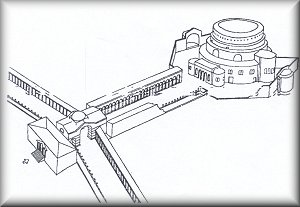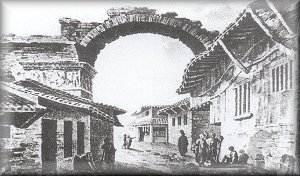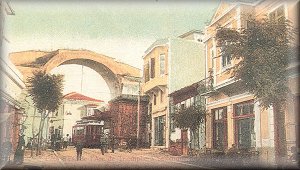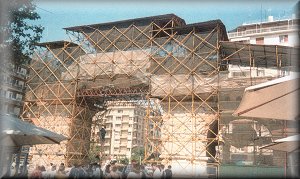
Galerius' Arch
Until now, two arches of one side have been saved although there are traces that show that a third arch existed, as well as the second (east) arch, at the time of its construction. Above the central arch there was a dome, based on a square base, traces of which exist today.
It was constructed with small bricks as all other buildings were like Rotunda, Galerius' Palace and the Octagon. The two central Draughts" with a 3.80 meters in width covered with marbled sculptures in four rows according to height. The top row of these marbled sculptures depicts battles of cavalry and the Roman Emperor Galerius on a horse entering the city and crowds of people welcoming him outside the gate. The very next row depicts battles between the Romans and the Persians.
From an artictic point of view the embossed depictions of "Kamara" do not convey special virtues and interest. The different forms have an obvious inflexibility and variance. However, the embossed depictions as well as the monument as a whole, are of great historical as well as archeological value, since monuments of this kind are very few in the world.
The triumphant Galerius' Arch was constructed by the Thessalonikians to honour the Roman Emperor when he returned to the city in the year 306 AD after his victorious expedition against the Persians.
This chronology was not easily accomplished and for centuries there were different points of view about the time of this monumental construction as well as of the person in honour of whom this monument was constructed. Initially, this arch was thought to have been built in honour of Alexander the Great, but later it was generally admitted that it was constructed in honour of Constantine the Great.
Later it was proved that the Arch was constructed in honour of the "Tetrarchy of Romans" and more specifically in honour of Emperor Galerius. It was also supported that "Kamara" is part of the housed "procession" route, which connected the Roman Palace with Rotunda making up the Emperor's Mausoleum. The picture (right) shows a reconstruction of the Arch of Galerius (kamara), the Rotunda and the two colonnaded streets as they must have been in the early Christian era.
The pictures avove show the "Kamara" area as it was during the Turkish occupation (18th c.)
and the "Kamara" area as it was in the beginning of the 20th c. (old post card)
When Galerius' Arch got its name from the Thessalonikians as "Kamara" is not known. The Italian traveler Lorenzo Bernardo, who visited Thessaloniki in 1591 called the Arch "Kamara" (Camara dell'Arco)
During the Turkish invasion, the district around "Kamara" (and Rotunda) was the part of the city which had pure Greek population. The people of "Kamara" area, the old Thessalonikians, strongly support and emphasise that their district was the center of Greek civilization during the Turkish invasion.
Galerius' Arch was restored in 1935. during the Turkish Invasion the monument suffered mutilation and destruction and many parts of it had been plastered by the Turks. The final appearance of "Kamare" was acquired 1953, after its renovation by the Municipality of Thessaloniki.
In the last 7 years a new restaurtion of Kamara has been undertaken ever since the nomination of Thessaloniki as the Cultural Capital of Europe for 1997. The objective of this restauration has been to preserve the history of one of our city's most famous monuments. The Arch has suffered extensive damages due to air pollution and constant maintenance is imperative.
Fig. 10. the restoration of Kamara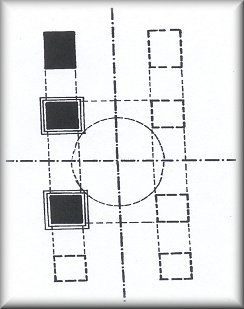 One of the most charcteristic monuments of Thessaloniki is Galerius' arch, the so-called "Kamara". Kamara dets back to the Roman times, to the time of Diaklitianos and Galerius (4th century AD) and is located to the east of Egnatia Avenue between Rotunda and Galerius' Palace. Today Kamara appears to have been chronically ahead of its time and later to have been included in the palace group. It is a triumphant arch, which must have been built immediately after 299AD. This monument was housed and it was consisted of two triple arches parallely placed, with their middle opening much bigger.
The diagram shows the ground plan of the Arch of Galerius.
One of the most charcteristic monuments of Thessaloniki is Galerius' arch, the so-called "Kamara". Kamara dets back to the Roman times, to the time of Diaklitianos and Galerius (4th century AD) and is located to the east of Egnatia Avenue between Rotunda and Galerius' Palace. Today Kamara appears to have been chronically ahead of its time and later to have been included in the palace group. It is a triumphant arch, which must have been built immediately after 299AD. This monument was housed and it was consisted of two triple arches parallely placed, with their middle opening much bigger.
The diagram shows the ground plan of the Arch of Galerius.
